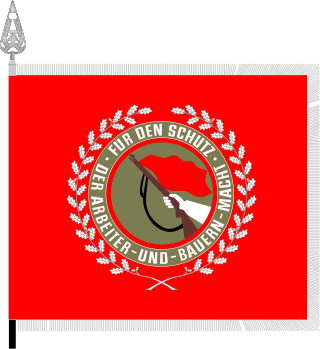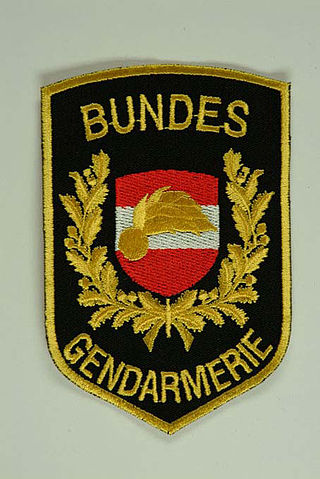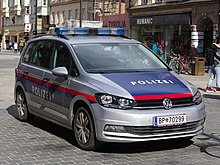
The Austrian Armed Forces are the combined military forces of Austria.
Oberstleutnant is a senior field officer rank in several German-speaking and Scandinavian countries, equivalent to lieutenant colonel. It is currently used by both the ground and air forces of Austria, Germany, Switzerland, Denmark, and Norway. The Swedish rank överstelöjtnant is a direct translation, as is the Finnish rank everstiluutnantti.

The Combat Groups of the Working Class was a paramilitary organization in the German Democratic Republic (GDR) from 1953 to 1989.

Modern Russian military ranks trace their roots to the Table of Ranks established by Peter the Great. Most of the rank names were borrowed from existing German/Prussian, French, English, Dutch, and Polish ranks upon the formation of the Russian regular army in the late 17th century.

Landespolizei is a term used to refer to the state police of any of the states of Germany.

In Austria, the Ministry of the Interior is a federal government agency serving as the interior ministry of the Austrian government. It is chiefly responsible for the public security, but also deals with matters relating to citizenship, elections, referendums, plebiscites and the alternative civilian service. The Ministry of the Interior is considered one of the most important ministries in Austria

The Federal Ministry of Defence, abbreviated BMVg, is a top-level federal agency, headed by the Federal Minister of Defence as a member of the Cabinet of Germany. The ministry is headquartered at the Hardthöhe district in Bonn and has a second office in the Bendlerblock building in Berlin, which is occasionally used as a metonym to denote the entire Ministry.

EKO Cobra is the tier one police tactical unit of the Austrian Federal Ministry of the Interior. EKO Cobra is not part of the Austrian Federal Police, but instead is directly under the control of the Federal Ministry of the Interior.

Law enforcement in Germany is constitutionally vested solely with the states, which is one of the main features of the German political system.

Law enforcement in Belgium is conducted by an integrated police service structured on the federal and local levels, made up of the Federal Police and the Local Police. Both forces are autonomous and subordinate to different authorities, but linked in regard to reciprocal support, recruitment, manpower mobility and common training.

Law enforcement in Austria is the responsibility of the Directorate General for Public Security, a subdivision of the Federal Ministry of the Interior located at Herrengasse 7 in Vienna. Over 20,000 police officers are on duty in the Federal Police at more than 1,000 police stations. On lakes and rivers the federal police has over 70 boats and other craft to act as the water police.
The Serbian Police, formally the Police of the Republic of Serbia, is the national civilian police force of the Serbia. The Serbian Police are responsible for all local and national law enforcement. It is under the jurisdiction of the Ministry of Internal Affairs.

Saarland Police is a state law-enforcement agency in Saarland, Germany. It is subordinated to the Saar Ministry of the Interior, Urban Development and Sports.

The Federal Gendarmerie was an Austrian federal police agency. It was responsible for approximately two thirds of the population on approximately 98% of Austrian national territory, alongside the Federal Safety Guard Corps (Bundessicherheitswachekorps) and Detective Corps (Kriminalbeamtenkorps). All Austrian law enforcement agencies were merged into the Federal Police (Bundespolizei) agency, with effect from 1 July 2005.

The municipal security guards existing in about 40 Austrian municipalities are police forces besides the Austrian Federal Police. They may also be called city security guard, municipal police (Gemeindepolizei), local police (Ortspolizei) or city police (Stadtpolizei). The larger of these forces form municipal guard corps with competences equal to the Federal Police. Some municipalities including most statutory cities are not allowed to maintain a guard corps.

The Hamburg Police is the German Landespolizei force for the city-state of Hamburg. Law enforcement in Germany is divided between federal and state (Land) agencies. A precursor to the agency, the Polizei-Behörde, has existed since 1814.
The Directorate General for Public Security is the governing body of general law enforcement in Austria and a division of the Ministry of the Interior. It oversees the Federal Police, the Criminal Intelligence Service, the Intelligence Directorate, the EKO Cobra, and the Aerial Police.

The Militia of SFR Yugoslavia was a law enforcement agency of the Socialist Federal Republic of Yugoslavia from 1944 to 1992. The Militia was subordinated to the Federal Secretariat of Internal Affairs.
Director general is a senior rank in police forces used.


























































